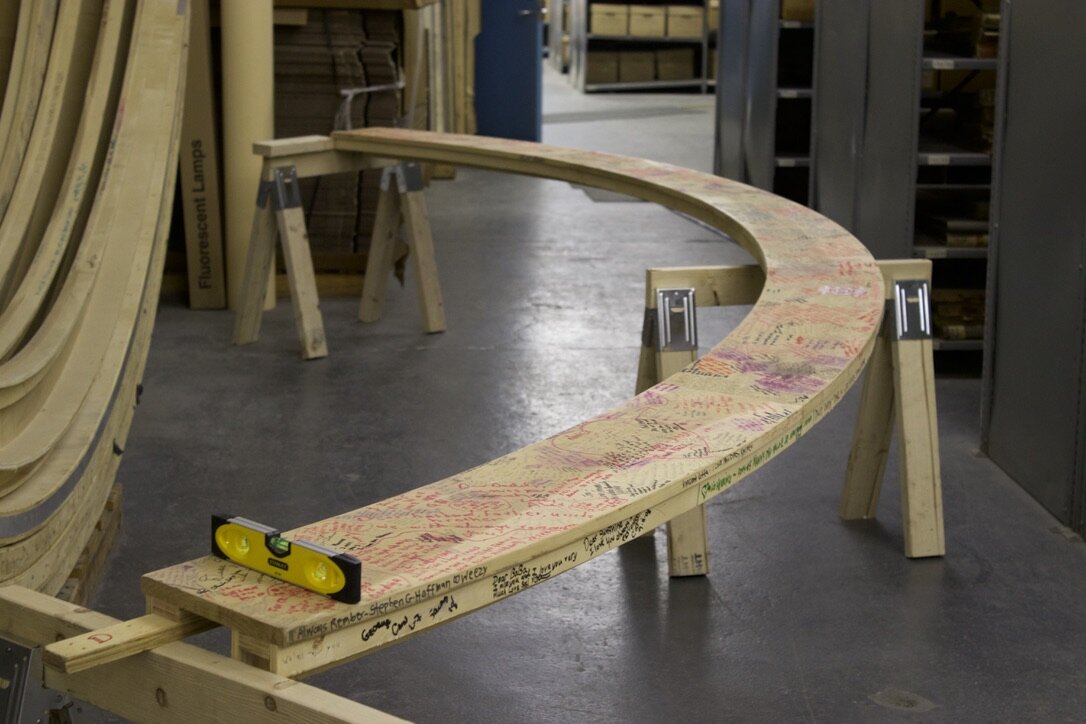The Municipal Archives recently launched a project to document the “risers” built for the annual 9/11 memorial services at the World Trade Center. Beginning September 11, 2002, New York City held annual memorial services for the victims of the terrorist attack on the World Trade Center.
Memorial pool at the World Trade Center, September 11, 2005. Photographer: Michael Lorenzini, NYC Municipal Archives.
For the first nine years, family members who gathered at the site for the services placed flowers and memorabilia in two water-filled pools representing the World Trade Center Twin Towers.
DORIS staff gathered mementos and flowers from a memorial pool at the World Trade Center, September 11, 2008. Photographer: Michael Lorenzini, NYC Municipal Archives.
The Municipal Archives preserved items left by friends and families at the site, along with the structural elements of the water-filled pools. Known as the “risers,” these wooden beams vary in size with some measuring approximately 18' x 10" (18 ft. long x 10 inches wide).
WTC Risers. WTC Riser Documentation Project, December 2020. Photographer: Pearl Boatswain, NYC Municipal Archives.
Between 2002 and 2008, the Archives retrieved 56 “risers” from the annual services. The symbolic pools were discontinued when construction of the new World Trade Center buildings covered the site.
WTC Riser. WTC Riser Documentation Project, December 2020. Photographer: Pearl Boatswain, NYC Municipal Archives.
The intrinsic value of the risers lies in the inscriptions written on them by family members. The inscriptions cover a gamut of emotions including sorrow, anger, and love.
Looking ahead to the twentieth anniversary of the attack in 2021, the Archives conceived the documentation project to ensure survival of these inscriptions, some of which are beginning to fade. The Archives will maintain several risers in its permanent collection. Some will be relocated to other institutions.
Temporary studio set-up at Industry City, WTC Riser Documentation Project, December 2020. Photographer: Pearl Boatswain, NYC Municipal Archives.
The Archives contracted a professional photographer, Stephen Mallon, for the documentation project. Beginning November 30, he used a medium-format camera to create high-resolution color images. Each riser was photographed in its entirety for documentation and then 12" sections were shot with a one-inch overlap. The sections will be stitched together to recreate a digital replica of each riser.
WTC Riser, WTC Riser Documentation Project, December 2020. Photographer: Pearl Boatswain, NYC Municipal Archives.
The planned second phase of the project will be to enter the names, years and inscriptions into a searchable database. Given the large amount of content the Municipal Archives is developing guidelines to “crowd-source” the data entry. This database will then be connected to the unique image which will allow families to find the inscriptions written years earlier.
WTC Riser. WTC Riser Documentation Project, December 2020. Photographer: Pearl Boatswain, NYC Municipal Archives.
The Municipal Archives will coordinate with other partners to complete this monumental project.






